Mark Sisson's Blog, page 317
December 2, 2013
Dear Mark: Gummy Vitamins, Heirloom Rice, and Regular Checkups
 For this week’s edition of Dear Mark, I’ve got three of your questions and three of my answers. First up, I discuss the sugar content of gummy vitamins. Is it a problem for growing kids? Next, find out my take on heirloom rice, including whether it’s worth all the work required trying to get around the antinutrients. I also get into the somewhat counterintuitive role of antioxidants after exercise. Last, I give my opinion on the importance (or lack thereof) of getting regular checkups or physicals at the doctor just… well, because.
For this week’s edition of Dear Mark, I’ve got three of your questions and three of my answers. First up, I discuss the sugar content of gummy vitamins. Is it a problem for growing kids? Next, find out my take on heirloom rice, including whether it’s worth all the work required trying to get around the antinutrients. I also get into the somewhat counterintuitive role of antioxidants after exercise. Last, I give my opinion on the importance (or lack thereof) of getting regular checkups or physicals at the doctor just… well, because.
Let’s go:
Hi Mark!
I am the mother of two amazing kids (4 & 3), and although we eat well I do like to give them a daily multi to cover our bases. We have been giving them Gummi Vitamins due to the convenience and “kid-friendliness” factor, but my husband recently looked at the sugar content (3g in the multi and 3g in the fish oil) and realized that for their body size it was the equivalent of us eating 6 sugar packets first thing in the morning! Can you and the worker bees recommend a child multi and fish oil that has a LOT less sugar but that they will still be willing to take?
Thanks in advance from the next generation of Grok

Heather
True, they are small, but according to official recommendations, active four year olds need between 1,600 and 2,000 calories a day and active three year olds need around 1,400. Six grams of sugar is 23 calories, or between 1-2% of calories (depending on age and calorie intake). That’s really nothing to worry about. Also, they aren’t just maintaining their body mass (or trying to actively lose some of it) like adults. They’re actually building new tissue, growing bones and teeth and brain. That burns through – and requires – a ton of calories.
Given the fairly consistent association between artificial sweetener intake and obesity in kids (which of course does not establish causation), I’d be wary of replacing the sugary vitamins with sucralosey vitamins.
Your best bet is to just focus on getting nutrients via food. At the very least, switch out the gummy fish oil for a DHA-enriched egg yolk or two. I’ll sometimes buy a brand from Whole Foods that gives you 150 mg DHA in each egg yolk, achieved by feeding the hens fish. That’s way better than most gummy fish oils, which only give about 50 mg of DHA per serving.
Don’t worry about the few grams of sugar if you give them the vitamins, though!
I don’t eat rice often (typically a bit when I go out for sushi), but I’ve been considering experimenting with it a bit as an occasional post work out carb source, to see how it effects me. I’ve been hearing recently about different heirloom rices, black, red, I think I saw something about a pink and a green. Most of what I’ve read has been talking about them having more nutrients, and antioxidants such as anthocyanin, compared to white or brown rice. I know the anti-nutrients in brown rice are in the germ, and the bran gets removed when producing white rice. From what I understand the heirloom rices retain the germ and the bran, but I haven’t been able to find anything one way or the other about anti-nutrients in any of these heirloom rices. I’m trying to find out if I should just experiment with white rice, or if these heirloom varieties could be worth looking into.
Carl
The colored heirloom rice varieties are pretty interesting. They’re certainly dense with antioxidant activity, mostly due to the anthocyanins (as you mention).
Unfortunately, if you want the color and the antioxidants, you need to eat the bran. That’s where everything is located, including antinutrients like phytic acid, which binds to many of the minerals. Even though heirloom rice is rich in minerals like magnesium and manganese, it’s unclear how much is actually available. If you soak and ferment your heirloom rice, you can eliminate the vast majority of the phytate, but that’s another step to follow. Luckily, most rice lectins are deactivated by cooking above 100 ºC or 212 ºF, so those shouldn’t be too big an issue. The rice’s trypsin inhibitor (the compound that can impair protein digested with the rice meal) is also deactivated by cooking (or removing the bran).
I’m just not sure the heirloom rices are worth the trouble of soaking and fermenting. You can certainly try it, but blueberries, cherries, and purple sweet potatoes require no special preparation and should cover you nicely on the anthocyanin front.
Besides, I wouldn’t worry too much about getting a big dose of anthocyanins immediately post-workout. I might even caution against getting a big dose of post-workout anthocyanins. There’s actually evidence that post-workout anthocyanins can impair the exercise effect. Sound weird? I know, I know. Anthocyanins and other antioxidant plant compounds are supposed to be good for you by reducing inflammation. What could be wrong with that?
Well, if you recall from the previous post on exercise and inflammation, a big part of the training process is inflammation. Exercise is a stressor that, like other stressors, increases inflammation in our tissues. It’s our body’s response to that inflammatory insult that explains the benefits of exercise. Lift weights heavy enough to damage the muscles and the muscles get stronger in order to handle the next bout. Run long enough to stress your cardiovascular system and your cardiovascular fitness improves so the next time you run isn’t such a stressor. Throwing in a big dose of antioxidants immediately after the workout blunts the inflammation and, thus, perhaps the beneficial response by our body to the exercise.
Studies have found that antioxidants in general taken after exercise can blunt the benefits of exercise. It remains to be seen whether large doses of anthocyanins (or blueberries, black rice, or cherries) have similar effects, but it’s possible:
In one study, cherry juice reduced the muscle damage after strength training and sped-up the recovery of strength. Two groups performed as many knee extensions as they could. 48 hours after the initial strength training, the group drinking cherry juice had recovered almost 93% of baseline strength and the control group had recovered just 88.5%. This sounds fantastic on the surface, but these were clearly truncated gains. Neither group was allowed to fully recover and, since the cherry juice attenuated muscle damage, the cherry group had less damage from which to recover. Generally, the greater the muscle damage, the greater the potential for strength gains – provided you give yourself enough recovery time. With sufficient recovery time, the control group might have ended up even stronger.
Another study found that acute ingestion of 375 grams of blueberries an hour before a bout of distance running reduced oxidative stress and increased the amount of anti-inflammatory cytokines in circulation.
Don’t go out of your way to avoid them, of course. A cup of blueberries won’t nullify the deadlifts you just did. Just don’t drink a quart of cherry juice followed by an intramuscular injection of purple sweet potato extract or you might shortchange your results.
If it’s easy, absorbable glucose you’re after, just go for the white rice. Make it more nutritious by cooking it in bone broth and a pat of grass-fed butter or red palm oil. Restore some of the lost minerals by adding a few splashes of trace mineral drops to the cooking liquid. Save the focus on anthocyanins and other phytonutrients for your regular meals.
Mark,
How do you feel about getting regular doctor checkups/physicals, especially considering that most of us only have access to CW-minded physicians due to insurance?
On a related note, I tend to overanalyze numbers and feel like I’d be more consistent in my Primal lifestyle if I can avoid the knee-jerk reactions that come with tracking things like blood test results, body fat, and even weight (things that, for the most part, Grok did not have access to). Is ignorance of these markers indeed bliss for my situation, or is it important for me to maintain awareness?
Thanks!
Weslee
It’s often said that prevention is the best medicine, with the implication being that one must regularly present himself to a licensed medical professional for examination if he is to prevent illnesses from occurring. I agree with the saying, but not with the common interpretation. The best way to prevent illness is to take a proactive role in your own health by eating well, staying active, performing vigorous exercise from time to time, lifting heavy things, getting adequate sunlight, doing things that you love, etc. – not by getting poked and prodded. Poking and prodding can be helpful, I suppose, if you’re not working from a healthy foundation.
In my personal opinion, which by the way is not medical advice, a healthy, lean, mobile, happy, content person does not need regular yearly checkups. There’s even a study from a couple years ago that found routine checkups provide no health benefits. Thus, I’m not big on going to the doctor unless I need to, like if I want to get a spot on my arm checked out.
Go to the doctor if something’s ailing you, if something hurts, or if you want to know your cholesterol levels or get some other lab number tested. Don’t fear the doctor if you need to go – they are excellent “mechanics” when something goes wrong – but don’t feel you need to go just because you’re alive and some horrible malady could be brewing inside you.
That’s it for today, folks. Thanks for reading!
Like This Blog Post? Dig Deeper with Primal Blueprint Books and Learn How You Can Reprogram Your Genes to Become Leaner, Stronger and Healthier

December 1, 2013
Weekend Link Love
 Our very own Tara Grant recently appeared on two different podcasts to discuss her new book, The Hidden Plague, as well as general autoimmunity, skin conditions, Primal sex, and orgasmic meditation. Check her out on Not Just Paleo and PaleoRunner.
Our very own Tara Grant recently appeared on two different podcasts to discuss her new book, The Hidden Plague, as well as general autoimmunity, skin conditions, Primal sex, and orgasmic meditation. Check her out on Not Just Paleo and PaleoRunner.
I’ve got a WellnessFX webcast coming up on Tuesday, December 10, where I’ll be explaining how to manage chronic pain and achieve your ideal body composition through simple lifestyle tweaks. Register for the webcast and get a chance to win a copy of The Primal Blueprint and a free WellnessFX Performance Package (a $699 value).
Research of the Week
How our posture affects our brains, our hormones, and our physiologies.
Reducing your daily step count has unfavorable metabolic consequences, even if you’re healthy.
Interesting Blog Posts
10 things one mother wants her daughter to know about working out. Good list, applies to sons as well.
Gratitude is great and all, but Frank Forencich is all about radical amazement. You probably should try it out, too.
Media, Schmedia
I recently sat down with Jack over at Tasting Britain to discuss a wide range of topics including the direction of the Primal movement, the use of entheogens throughout human history, which dwarf from the Hobbit I could beat up, my rock duet with zombie Jim Morrison, and my biggest inspirations in life.
Some hospitals are trying out yogurt to help prevent serious infections like C. diff from taking hold, and they’re getting good results.
Everything Else
In case you weren’t aware, MDA has a Pinterest account. Here are some of the Primal Holiday Recipes we recently pinned. Check it out and get inspired (and hungry).
You can stop gum disease, according to one ancestrally-minded dentist.
7 things you (probably) had no idea the world was running low on. Sardines, wine, chocolate, bacon? This is a frightening list.
Recipe Corner
Put all those Thanksgiving ingredients to good use and make a sweet potato latke turkey burger, or Thanksgivukkah Burger.
Left over cranberries? Braise ‘em with some short ribs!
Time Capsule
One year ago (Dec 1 – Dec 7)
The Physical Benefits of Positive Emotions – From the people who brought you “The Physical Toll of Negative Emotions” comes its direct counterpart!
Should We Ice Injuries? – I explore whether or not the advice to ice your injuries is another dud from the annals of conventional wisdom.
Comment of the Week
In Southern California, they start shivering at anything below room temperature.
- Ha. Touché!
Like This Blog Post? Dig Deeper with Primal Blueprint Books and Learn How You Can Reprogram Your Genes to Become Leaner, Stronger and Healthier

November 30, 2013
Primal Mocha
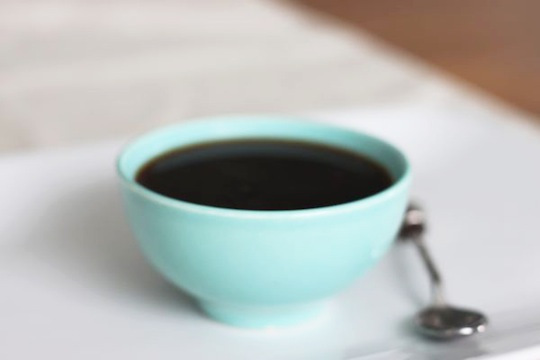 We’ve got a super simple recipe for you today. After all the Thanksgiving festivities, simpler is probably better in the recipe department.
We’ve got a super simple recipe for you today. After all the Thanksgiving festivities, simpler is probably better in the recipe department.
So, start with your favorite cup of piping hot coffee and drop in a square of high-quality dark chocolate. Add a pinch of cinnamon. You can stop there if you like. Or, gussy it up with whatever transforms your Primal Mocha into an irresistible beverage: a little sweetener, a drizzle of heavy cream or coconut milk, a pinch of cayenne or nutmeg, or a drop of vanilla. Drink it straight up or throw it the blender to create a frothy coffee. And don’t forget a pinch of sea salt; it amps up the flavor of everything.
Why mess with a perfectly good cup of regular coffee? If you crave a mocha, this barely-sweetened, antioxidant-packed version is way healthier than anything you could buy in a coffee shop. Should you drink Primal Mochas every day? You could, but why would you when there are so many other delicious ways to fill your mug? Don’t forget about Primal Egg Coffee, Primal Egg Nog, or Egg-less Nog and Primal Hot Cocoa.
What are your favorite ways to dress up a plain cup of coffee?
Servings: 1
Time in the Kitchen: 5 minutes
Ingredients:
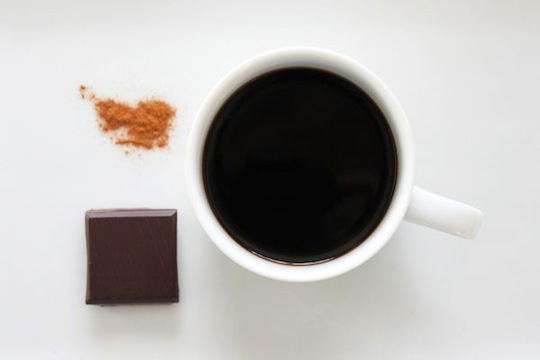
1 cup of coffee
1 square of high-cacao dark chocolate
Pinch of cinnamon
Optional add-ins: pinch of sea salt, heavy cream, coconut milk, vanilla, and/or a sweetener of your choice
Instructions:
Drop the square of dark chocolate into piping hot coffee. Stir well as the chocolate melts.
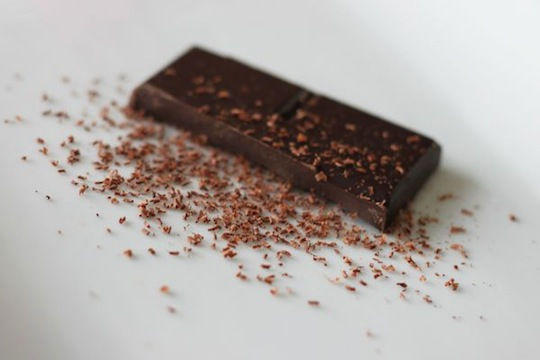
Add additional ingredients as desired. Drink straight up or throw in the blender (or use an immersion blender ) to froth it up.
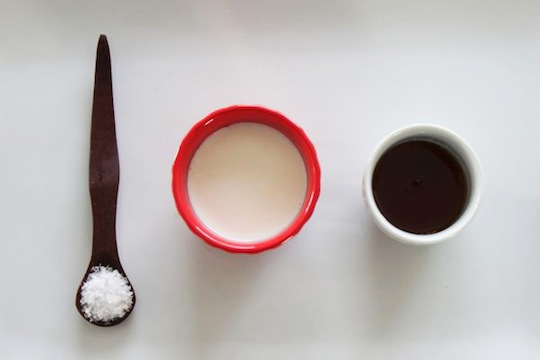
Use a spoon to stir as you drink, as the chocolate settles towards the bottom.

Not Sure What to Eat? Get the Primal Blueprint Meal Plan for Shopping Lists and Recipes Delivered Directly to Your Inbox Each Week

November 29, 2013
Small Changes Lead to Dramatic Results
It’s Friday, everyone! And that means another Primal Blueprint Real Life Story from a Mark’s Daily Apple reader. If you have your own success story and would like to share it with me and the Mark’s Daily Apple community please contact me here. I’ll continue to publish these each Friday as long as they keep coming in. Thank you for reading!
 I hated gym class. Especially the mandatory showers down in the locker room dungeon of the school basement. And those uniform gym shorts were obnoxiously baggy on my toothpick legs (think SpongeBob). The obstetrician (pediatricians weren’t invented yet) told my mother I would always be tall and thin.
I hated gym class. Especially the mandatory showers down in the locker room dungeon of the school basement. And those uniform gym shorts were obnoxiously baggy on my toothpick legs (think SpongeBob). The obstetrician (pediatricians weren’t invented yet) told my mother I would always be tall and thin.
In middle school, I was no candidate for the Presidential Physical Fitness Award. At 5 foot 10, I had no trouble reaching the chin-up bar, but that was about it. Just hanging there without bending my arms eliminated any possibility of a gold medal. That bar was my arch-nemesis. At least I could touch the ceiling rafters at the top of the rope climb since I only had 98 pounds to hoist all the way up into the stratosphere. It was also a challenge to my parents’ shopping endurance when trying to find bell bottomed pants that would fit the way they were supposed to. And don’t forget the high-heeled shoes… man.
Fast forward 40 years. I still hate the thought of gym class, but weighing in at 168 and standing 6′ 1” barefoot, I can do 8 to 10 mini Primal pull-ups on my makeshift bar in the rafters of our basement ceiling. (I am working up to at least a couple of good “honest” ones.) This might not seem like much of a success story since I am still tall and thin and relatively fit while sliding into a 32×34 pair of pants, but my path did not go straight from point A to point B. There were plenty of twists and turns, ups and downs, pot holes and speed bumps along the way. But there were also some scenic byways, picturesque overlooks, and panoramic views.
I was pretty much a geek growing up, complete with thick glasses. I started out on trumpet in the school band, was in the Science Club, and rode my bike a lot. Living in a small town put everything within walking or biking distance. When some of my gear-head friends were getting cars, I got a new 10-speed bicycle on my 16th birthday. I was in heaven.
I put in many sunny summer afternoons on county roads sailing between patches of cornfields, and even squeezed in a couple of century rides along with several jaunts to Columbus and back over long weekends, pedaling 60 miles each way. In college I played the baritone horn (after switching from trumpet in 8th grade) and was a 3-year member of the Ohio State University Marching Band when Archie Griffin was running for his second Heisman during my freshman year.

Those were the lean years. Carrying around 145 pounds on a 6 foot 2 frame, I had plenty of weight training back then, from flashing and maneuvering that 15+ pound brass horn coupled with heavy-duty cardio: exhaling continuously through that horn while marching over 100 yards down the field at a pace of 180 steps per minute playing “Buckeye Battle Cry”. And this was just the opening for the pre-game show.
But then in November of 1977 I became entangled in a complicated freak accident where I was figuratively caught between a rock and a hard place and was literally squished across the abdomen resulting in stretched and pulled muscles, torn cartilage from my ribs, a twisted pelvis, and one leg shorter than the other. They did not find any internal damage at the time, but I was sentenced to a sedentary lifestyle at the age of 21. I guess that was o.k., being a geek-type pencil pusher, and I eventually ended up as a Data Analyst specializing in Geographic Information Systems (GIS).
Needless to say, my exercise regimens were limited in scope. Walks around the neighborhood worked, but strolling through art exhibits or meandering around the State Fair proved strenuous at that slow pace. It was hard on the hips, and standing for extended periods of time put pressure on the lower back. I could manage short bicycle trips since I was seated, but they came with a 10 mile round trip limit. Years of chiropractic helped put the hips back in alignment and straighten the leg, but because of the way it originally healed (remember the Crooked Man in the crooked house?), I had to keep coming back for ‘maintenance’. Yoga has helped to maintain my elasticity, though. Throw in some Alexander Technique and Ayurveda and I managed to maneuver around.
Life continued to happen: school, work, marriage, relocation, more school, more work, helping to bring two red-headed boys into the world while gaining five pounds per child (or is that supposed to apply to the mother?). Recent family holiday photos reveal a few decades of accumulation (Christmas 2011 with our pre-Primal, pre grain-free cats).

Then came that pivotal check up in May of 2012 with my Nurse Practitioner. I had been teetering on the edge for several years, but this set of blood tests pushed me over the limit. It was SAD but true: I had become a product of Conventional Wisdom’s Standard American Diet. The numbers went something like this:
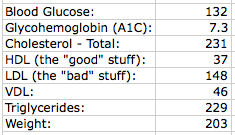
I was a prime candidate for Syndrome X and type II diabetes.
I was already on a prescription to control my blood pressure, and I did not like the idea of signing up for any new medications. I had briefly been on statins a few years back, but that was like wearing one of those lead vests they put on you when getting x-rays at the dentist’s office. For a month I was continually fatigued, my muscles were weak, and the walks up that hill down the street became a climb up Mt. Everest. Taking that pill to help reduce cholesterol while attempting to increase exercising as a lifestyle change to achieve the same goal seemed to be self-defeating.
Now, handed these latest numbers, something had to change.
The first thing to go was sugar (pop). Then came salty fried stuff (French fries and potato cakes) along with other saturated fats (margarine, vegetable oils) and processed food. My Nurse Practitioner said something about carbs and pasta, so… you guessed it.
During this preliminary phase, both the Mrs. and I had been exploring more healthy diets with the hope of shedding a few unwanted pounds. Her sister had found something that worked for her, and the two of them incorporated that strategy into mealtimes for a week while visiting their father during the summer. I had found a book among my mother’s things that addressed sugar and the glucose/insulin roller coaster, and I had a chance to apply some of the principles explained in those pages during my week of bachelorhood. Soon after the Mrs. got back home, we joined forces and started experimenting with what we had discovered. But it seemed like both of our new approaches centered around just managing and regulating that glucose/insulin cycle using high fiber foods and complex carbohydrates.
Stuck right in the middle of all these discoveries was our cruise to Alaska in July. We both ate like typical cruisers, but we stayed active exploring the ship and enjoying shore excursions. We also made better choices from the endless and vast selection of available food – fewer pasta dishes, no sugar-laden beverages, lean meats accompanied by more fruits and veggies, bacon and eggs for breakfast, and, of course, a daily dip of ice cream – don’t forget the simple pleasures! But even though we both ate till we were full, upon returning home to our bathroom scales a week later, the dial had barely budged from where we left it. We must have been doing something right.
During the cruise we attended a workshop discussing metabolism and detox. There are different ways to do it (detox), but unless you scrape off all the chips of old paint and get rid of the moisture issues, the freshly painted wall is just going to crack and peel again. And if you keep throwing mud at your nice clean wall, unless you have a peculiar affinity for Mud Art, the room will never really be a nice room. That is where the Primal Blueprint comes in.
Since we were already in “detox” mode, we continued cleaning up our act. Besides the dietary changes we had made prior to the cruise, we learned more about the water we drink and the containers that we drink it from. [See The Choice Is Clear (1971) by Dr. Allen E. Banik and Plastic Free (2012) by Beth Terry] If you ever have a question about something or a desire to find out more about anything at all, there is Google. Type in “safe water bottles”. Hit enter.
One of the search results linked to Mark’s Daily Apple where some guy with the same name as mine and being about the same vintage – but looking more like 40 – was giving his take on water bottles. I loved his writing style, his attitude, his undying curiosity, and his outlook on life. I began exploring his website further and discovered The Primal Blueprint.
One fundamental thrust of this new “ancient” lifestyle was eliminating grains from the diet. I found this to be greatly reinforced and explained in Dr. William Davis’ book, Wheat Belly. Up to this point, after each modification to our eating habits with its accompanying weight loss, homeostasis would soon settle in and the bathroom scales would start creeping back up again. But taking the Primal “plunge” in late October 2012 (Happy Primal Anniversary! by the way), I ate my last spoonful of grain based cereal and drank my last glass of fruit juice for breakfast.
As a direct result of that one little change, my next blood test results in February 2013 were dramatic. After a year of being Primal fat burners, the numbers settled down and both of us had shed pounds without really trying. The Mrs. had reached her goal by dropping 20 pounds and stepping into her jeans two sizes smaller. She had other health related targets she was pursuing, and has become re-vitalized as a result of going Primal. She also happens to work in a library and has had dozens of opportunities to “suggest” the Primal Blueprint to patrons checking out other books related to diet and health, and the library’s three copies seem to be in circulation most of the time.

Along with the improved numbers, my prescribed dosage for blood pressure medicine has gone from 10 mg to 2.5 mg, and my weight has been hovering around 168 for many months. Some additional things may be due more to the weight loss and reduced systemic inflammation, but my ankles are no longer swollen (edema), my back, hip, and knees don’t ache any more, the stairs are no longer a strain, and I have more vibrant energy. The time between chiropractor visits has stretched from 3 weeks to 6. And I somehow managed to side-step the cold and flu season last year while the rest of the office staff were dropping like flies.
Today I still play the baritone and euphonium in a British style brass band and ring handbells. I go nowhere at a moderate pace on my stationary exer-cycle with an occasional “sprint”. I move frequently out to the warehouse and back to my cubicle every hour at work followed by a dozen Primal Squats. Yoga has become so much more effective and meaningful. And I don’t miss pop or fries or hot dogs or breakfast cereal or juice or pasta or bread, but guided by the Calton’s Rich Food, Poor Food GPS, I love exploring cooking and combining new things that are wholesome and taste full-flavored which don’t leave me in a food coma for the rest of the day. The funny thing is, when I backslide and indulge in a couple of cookies or a stack of pancakes, all my joints ache for at least two days.
There are still a few things to work out like improving some of the numbers, increasing the Primal Essential Movements (PEMs), and doing some visceral fine tuning (translation: ripped abs). We are all a work in progress, but after reading The Primal Blueprint, I have gained new insight and a deeper appreciation for how we are designed and put together, and I have a renewed respect for the Designer.

Mark W.
Order The Primal Blueprint Starter Kit and Take Control of Your Health Today!

Grok Friday Sale: The Just Released Primal Blueprint Box Set plus Free Gifts
 I’m not usually a fan of Black Friday. I might click around online and snag an easy deal or two, but I won’t watch the clock to get “lightning deals,” I won’t wake up at the crack of dawn to buy a $5 laptop, and I won’t fight crowds to save $20 on a toaster (even if I did eat toast). Black Friday is better spent eating leftovers and hiking with the family. That said, I’m offering a great Black, nay, Grok Friday promo for loyal readers of MDA that won’t keep you from getting the most out of your day off.
I’m not usually a fan of Black Friday. I might click around online and snag an easy deal or two, but I won’t watch the clock to get “lightning deals,” I won’t wake up at the crack of dawn to buy a $5 laptop, and I won’t fight crowds to save $20 on a toaster (even if I did eat toast). Black Friday is better spent eating leftovers and hiking with the family. That said, I’m offering a great Black, nay, Grok Friday promo for loyal readers of MDA that won’t keep you from getting the most out of your day off.
Read on to see what it’s all about.
But first, let me tell you what it’s not.
It’s not shiny (well, except for glossy book covers and spinning 3D image).
It’s not a plastic piece of junk that for some inexplicable reason you want because it’s on sale and other people might get to it first.
Well, What Is It?
A Box Set collection of the essential Primal Blueprint literature, including:
The Primal Blueprint (original hardcover edition)
The Primal Connection
The Primal Blueprint Cookbook
The Primal Blueprint Quick & Easy Meals
Primal Blueprint Healthy Sauces, Dressings & Toppings
You get all that – a retail value of $142 – for just $79.96 (20% off the retail price of $99.95), plus a couple free extras which I detail below.

Okay. Who’s It For?
Total beginners to this Primal thing can jump in at the best price possible and get everything they need to get started and get it right: the foundation of the ten laws covered in the first book, the stress management and peace of mind offered in The Primal Connection, enough recipes to last half a lifetime in the two cookbooks, and dozens of ways to keep those recipes fresh with Healthy Sauces, Dressings & Toppings.
Primal diehards can finally give out their dogeared copies of the books to friends and family while getting the slick collector’s box set for their own collection.
Anyone who wants to learn about Primal living or brush up on their knowledge. The website is a great, free resource, but several million words are a lot to wade through. The books both condense and expand on the most important topics covered on MDA. This box set was a way for me to make the books as affordable as possible for as many people as possible. This is important information that may change your life, and it needs to reach eyes and minds.
Why You Should Order the Box Set Today
It makes a great gift – for yourself or someone else. And if you don’t have anyone who’s quite worthy of a $99 box set, nothing’s stopping you from breaking it up and giving them out piecemeal. Buying the box set today just cuts you a really good deal.
It isn’t subject to planned obsolescence like other Black Friday offers. Unlike that fancy new tablet you roundhouse kicked a pregnant lady to grab, the knowledge, wisdom, and practical advice contained in these books will be just as useful twenty years from now.
You’re a fan of Mark’s Daily Apple. Proceeds from sales of this promo will provide direct support for MDA.
You want to spread the Primal message. Emails with links to blog posts only get so much traction with your friends. Hand ‘em a book or two and they’ll pay attention.
Plus, you get some great gifts when you order:
You get a free choice of any Primal Blueprint apparel item. Add both the Box Set and your choice of apparel item to your shopping cart and use the coupon code “FREEAPPAREL” at checkout. Seriously, any item: hoodies, t-shirts, apron, polos, and tanks are all fair game. (One free apparel item per box set purchase.)

You get a free Primal Blueprint Poster (retail value $14.95), and FREE laminated Primal Blueprint Shopping List and Dry Erase Pen. Easy reference guides to help you shop and live Primally. You don’t have to do anything special but order the set; we’ll throw the poster and shopping list into your order for you.

You get a free Grok decal. Same thing. You don’t have to do anything special; we’ll include the Grok decal with your box set order.
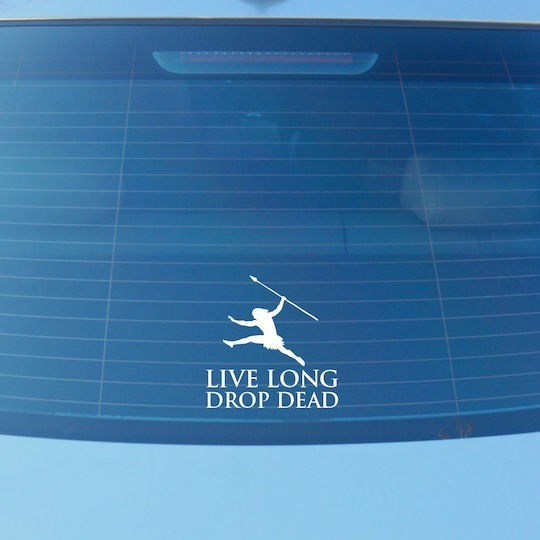
And don’t forget, you get an additional 20% off when you check out. Under $80 for five fantastic Primal books is nothing to sneeze at, folks.
Avoid the crowds and craziness. Click a couple links, enter a few bits of payment information, and you’re done. You can log off, shut down the computer, and enjoy the rest of your day without even looking at a web browser or sniffing a crowd. Revel in the post-turkey haze.
The offer’s good until December 18, 2013, which is the last date we can reliably ship box sets in time for Christmas.
One last time, put succinctly:
5 books, a $142 value, for just under $80.
Free Primal apparel item of your choice (put it in your cart with the box set and use coupon code “FREEAPPAREL” at checkout).
Free Grok decal.
Timeless knowledge.
Grab it today (or anytime by Dec. 18, really)!

November 28, 2013
The Benefits of Giving Thanks
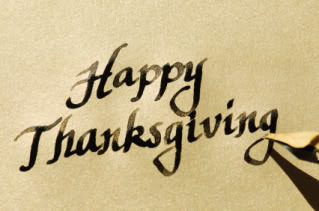 As many of us sit down to impressive feasts today, we’re undoubtedly thankful for the food on the table and the company that surrounds us. Our thoughts might peruse the events of the year – the many happy days enjoyed, the hard times weathered. Whatever the content of the year’s storyline, we made it intact and bring an attitude of gratitude for the chance to reflect, celebrate and share. There’s something to the mindset of the day. For those hours we see the upside. We focus on feeling fortunate – even abundant.
As many of us sit down to impressive feasts today, we’re undoubtedly thankful for the food on the table and the company that surrounds us. Our thoughts might peruse the events of the year – the many happy days enjoyed, the hard times weathered. Whatever the content of the year’s storyline, we made it intact and bring an attitude of gratitude for the chance to reflect, celebrate and share. There’s something to the mindset of the day. For those hours we see the upside. We focus on feeling fortunate – even abundant.
More than a particular holiday’s theme, gratitude can be a potently rich and beneficial lens we bring to life. When we appreciate what we have, we’re likely aware of the larger good around us, of the good that can come to us. If we’re on the habit of noticing – and celebrating – the favorable in our days, we’re likely ready and willing to anticipate and accept more of it into our lives. It’s interesting to me how it can become a self-fulfilling prophecy – of the positive kind. Likewise, it’s intriguing to see how the research supports this general idea as well. The more grateful we are for what we have, the happier more well-adjusted and even healthier we are.
In a study (PDF) that compared three groups, including one group that was asked to write about the “hassles” of their day, another group that was instructed to write down whatever they were grateful for that day, and finally a third group that journaled about neutral happenings in their day. Study conditions varied to measure outcomes when writings were weekly and daily. Those who wrote about their gratitude reported an overall higher sense of well-being across several measures than the other two groups.
It’s part of what researchers label “prosocial behavior,” those behaviors that support the implicit social contracts of human interaction and relationship building like displays of empathy, offering aid and support, etc. Other research has shown that being on the receiving end of a person’s gratitude can boost subjects’ sense of self-worth and/or self-efficacy. It also appears to encourage participants to further help the person who offered the gratitude but also another, unrelated person in an unconscious “pay it forward” kind of connection. The connection explains why grateful people are simply easier and more pleasant to be around. Think of it from an evolutionary standpoint: who would Grok have wanted in his tribe? Who would you want?
On a physical level, subjects who felt higher levels of gratitude exercised more and suffered less from illness in one study (PDF). Being grateful can even help us rest more easily at night – literally. In one study, participants with higher levels of gratitude reported better quality sleep and longer sleep duration. The researchers noted the importance of “pre-sleep cognitions” and their potential impact on sleep experience. (Think of that before bed each night….)
Of course, we’re not limited to saying thanks a single day each year, but today is a good day to start. Gratitude can work like a muscle. The more we exercise it, the stronger it gets – and the bigger benefit we feel from it. If it sounds too self-serving to put it that way, look at it as we do self-care. The more we take care of ourselves, the better able we are to care for others. Likewise, our gratitude offers a positive energy to those around us. It enhances our satisfaction in our relationships and encourages us to give back. We’re happier in our lives, less aggressive and resentful. Imagine how that contentment serves others (e.g. children, partners, coworkers, family and friends, community) in a myriad of ways.
Cultivating gratitude as a regular practice doesn’t have to be complicated. Doctors Randy and Lori Sansone in their analysis of the research on gratitude suggest everything from journaling to thank you notes or letters to meditating on gratitude. There’s something to sharing your gratitude, however. There’s something to offering it to the person you’re grateful for, and it won’t be just him/her that benefits. (Check out some inspiration here. A few of you might want tissues handy.)
Make gratitude a family affair and get the kids in on it. Ask them what the best part of their day was or keep a large jar with slips of paper next to it. Encourage everyone to write down what they’re grateful at least once a week. Not only will you be offering your kids a lesson in appreciation, you’ll be boosting their self-worth – and creating a meaningful way to celebrate Thanksgiving the following year when you can read these recorded gratitudes together.
What are you grateful for this year? What are you celebrating, and how has it changed you? Who or what has inspired you or sustained you lately? With my own gratitude to this amazing community and the enthusiasm, support and challenge it offers me, I wish everyone a Happy Thanksgiving. Be well.
Order The Primal Blueprint Starter Kit and Take Control of Your Health Today!

November 27, 2013
A Day in the Life of Mark Sisson
Back when I started Mark’s Daily Apple, it was a small operation of just a few people with basic goals: offer my take on health, fitness, and nutrition topics. I researched and wrote the articles, and that was pretty much it. Very straightforward.
As everything has grown larger and more complex, my responsibility has expanded. I tackle ever more complicated topics that require even more research – and have a team devoted to research. The business has grown to encompass events, supplements, apparel, services, and a growing list of books, which all comes with additional duties and oversight. And amidst all that, I’m still writing articles on a daily basis.
My expanded roles mean that I can’t waste time. If I do, I may get the work done, but I’ll have nothing left at the end of the day. My social life, my fitness, my family, and my sleep will all suffer. Those things are non-negotiable, so I shot a video explaining my strategies for remaining productive, getting the work done, limiting stress, and maintaining a healthy work-life balance that you may find helpful.
I can’t wake up and launch right into work. It feels like going right into fight or flight mode if I try to start immediately, and I end up all over the place. Instead, I start the day with a cup of coffee, the newspaper, and a few puzzles. The coffee and the puzzles get the cognitive gears going and the paper gives me a glimpse of the outside world before plunging myself into the world of health and nutrition research.
For an hour or so I check and answer email and take/make phone calls, prioritizing the most important or time consuming ones first. This is nuts and bolts stuff that I can do without thinking too hard or getting creative. I just have to sit down and do it. It allows me to tick something off the list and move onto more difficult tasks with a small victory under my belt.
Then I take a short break, maybe ten or fifteen minutes. Since I work from home and answer to no one but my own guilty conscience, I get to take a lot of breaks. They’re essential to my success.
Now it’s on to the real heavy lifting: the creative work. I’ll buckle down and work on a blog post for an hour or two in my office, closing out (and sometimes even blocking) all the email and other time-sucking website and apps. Ideally, I’ve already done the research and a basic outline for this post, so I know where I’m going and what I’ll be citing. This lets me focus on the prose itself without digging through the literature. If it’s just not happening, I’ll switch spaces and move outside with my laptop. I find a change in scenery is absolutely crucial for jump starting the creative process. It doesn’t even have to be outside. You could just go to another room, or even go from sitting to standing or standing to sitting. Just switching up something minor is often enough.
Then it’s off to the gym for training and socializing. The social aspect is almost as important to me as the physical part of working out. I need that face-to-face contact to recharge. I need to get my training out of the way so I don’t have it hanging over the rest of my day, interfering with my focus on work.
After the gym, I eat – usually a Big A$$ Salad (BAS). 1150 calories, 66% fat, 18% carbs, 16% protein, tons of colorful veggies. It’s my biggest meal of the day and gives me steady, even energy. Well, sometimes I’ll fast an hour or two after my workout to eat for the growth hormone boost.
I spend the rest of my workday researching for future posts or books, catching up on any manuscripts or proposals, checking emails, popping into the office, and just generally taking care of random stuff that pops up.
Once darkness falls, I (try to) log off. Nighttime is family time, but occasionally work calls. I always have f.lux installed and my blue-blocking goggles on hand to combat the circadian disruption caused by blue light. That way I can finish work and get right to sleep without missing a beat.
Workday Strategies
Make a gradual transition into your peak performance state – If you can launch right into work, fine. Do it. Most people, like me, can’t. Give yourself a “work warmup” in the morning. Do something that gently uses your brain without stressing you out.
Emphasize focused, distinct periods of work – Communication (emails, phone calls, texts, chats), creation (actually doing the work), personal time (breaks, gym, meals). Don’t run yourself ragged trying to do everything at once. You’ll fail and the work will suffer.
Take frequent breaks – Humans can only focus on one thing for about 20 minutes, give or take. If you try to marathon your way through the workday, you’ll be wasting a ton of time floundering on tasks when you could just stop for a few minutes, take a deep breath, and come back to knock it out of the park.
Nurture energy and motivation – Eating well, exercising regularly, and maintaining a narrow focus will keep you energized and motivated.
Minimize screen use after dark – Try your best to not work after dark. You need that uninterrupted block of free time to unwind, go out, hang out, and recharge for the next day. If you absolutely must work late, install f.lux and use some blue-blocking goggles.
How do you work? What are your strategies? Let me and everyone know in the comment section!
Have You Seen the New Primal Book? Discover The Hidden Plague and the Special Offer That Expires on Nov. 30

November 26, 2013
A Primal Thanksgiving Menu (plus a Contest)
 It’s two days away from Thanksgiving here in the United States, and that means a significant portion of my readership is scrambling to put together a Primal menu. Things are easier now with the rise of the ancestral health community and the growing preponderance of related recipe blogs, but a lot of you are still wasting precious time combing through their volumes or converting standard Thanksgiving recipes into Primal-friendly recipes. You have better things to do. You have family and friends to visit, footballs to toss (or kick, as the case may be), piles of polychromatic leaves to roll around in, and thanks to give. Even if you’re an international reader, don’t celebrate Thanksgiving or know quite what it’s all about, you still like to eat great food.
It’s two days away from Thanksgiving here in the United States, and that means a significant portion of my readership is scrambling to put together a Primal menu. Things are easier now with the rise of the ancestral health community and the growing preponderance of related recipe blogs, but a lot of you are still wasting precious time combing through their volumes or converting standard Thanksgiving recipes into Primal-friendly recipes. You have better things to do. You have family and friends to visit, footballs to toss (or kick, as the case may be), piles of polychromatic leaves to roll around in, and thanks to give. Even if you’re an international reader, don’t celebrate Thanksgiving or know quite what it’s all about, you still like to eat great food.
That’s why we’ve done the work for you. My team and I have put together a comprehensive recipe list of Thanksgiving meat dishes, sides, stuffing, gravy, desserts, and appetizers so that you assemble your ingredients today and get all the preparation out of the way. Nobody likes being that last guy in the grocery store on Thanksgiving Eve picking through spindly pathetic 9-pound or ridiculous 30-pound turkeys because he didn’t plan ahead. Use this list to avoid that situation.
Be sure to stay tuned for a contest at the end of the post!
Meat Dishes
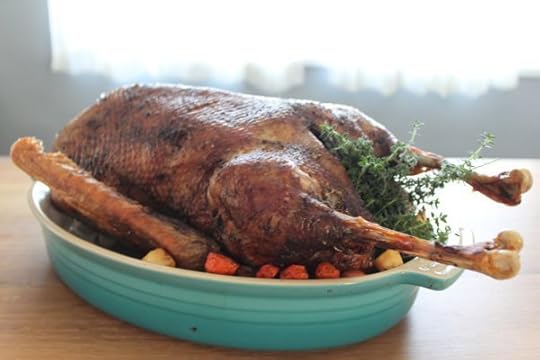 Most meat dishes are pretty easy to Primalize. Buy a pastured or grass-fed animal, sub in a healthy fat for whatever seed oil they call for, and you’re good to go. If there’s a crust on it, make sure you’re using something like coconut flour instead of white flour. Otherwise? Very straightforward. Still, the Primal/paleo community has a unique acumen when it comes to animal flesh. We know what’s good and how to cook it, so it’s a good idea to look to them for meat recipes.
Most meat dishes are pretty easy to Primalize. Buy a pastured or grass-fed animal, sub in a healthy fat for whatever seed oil they call for, and you’re good to go. If there’s a crust on it, make sure you’re using something like coconut flour instead of white flour. Otherwise? Very straightforward. Still, the Primal/paleo community has a unique acumen when it comes to animal flesh. We know what’s good and how to cook it, so it’s a good idea to look to them for meat recipes.
Heritage Turkey and Mashed Parsnips - Heritage turkeys are best, having more dark meat (so dark in fact that it looks a bit like red meat), fat, and flavor than the broad-breasted white-meated mutant birds we’ve grown accustomed to, but this recipe will work with any turkey variety. Pro tip: In recent years I’ve been doing a dry salt brine, where you salt the turkey two or three days before cooking it, inside and out. Use about a tablespoon of kosher salt for every 5 pounds of turkey, and really rub it in. This locks in moisture and results in a flavorful, not salty, bird. Just make sure to omit the salt from any recipe you use if you do a salt brine. The drippings will also be rather salty, so keep that in mind when making gravy.
Succulent Roast Goose - You’ve spent your entire life being ridiculed by the geese down at the local pond. The loaves of white bread you tear into little pieces and toss to their gaping beaks are never enough. They’re your best friend when you’re rolling in baked dough and spurn you when you’re not. You even got Udi’s one time for that grey gander with celiac, only to have him poop on your shoe. Such ungrateful jerks, those geese. This recipe is your chance to even the score. Plus, it’s delicious and produces about a quart of high quality goose fat, perfect for roasting sweet potatoes.
Cornish Game Hens with Egg and Sausage Stuffing - What’s better than a single serving bird? It’s almost like they were meant to be eaten.
Foolproof Prime Rib - Prime rib isn’t a traditional Thanksgiving meat dish, true. Poultry is the preferred genre, yeah. Who cares? Shake things up with J. Stanton’s simple recipe! Plop a six pound piece of beef on the table. Eyebrows and hackles may raise up a bit, but you’re used to that by now. Plus, once those meat juices are running down their chins, they’re locked in. No going back. Get fancy and go with a bison roast, if you’ve got one handy.
Baked Fresh Ham - Cured hams are tricky. To cure your own is a huge undertaking (plus, it’s too late to get started) and most commercial hams are full of sugar. Luckily, you can bake a fresh ham roast, control what goes into it, and end up with a great piece of holiday meat.
Holiday Spice Rubs - Pick one of these spice blends and rub it into/onto the slab of animal of your choice. It’s bound to taste great, impart seasonality, and reduce the formation of carcinogens and oxidation products.
Stuffing
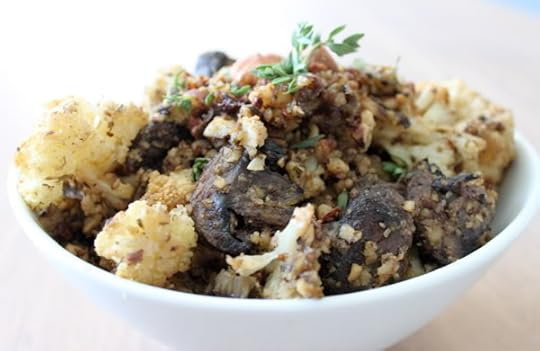 Stuffing poses an obvious problem that’s difficult to circumvent: it’s made of bread. Never fear, for the Primal community has made quick work of the roadblock.
Stuffing poses an obvious problem that’s difficult to circumvent: it’s made of bread. Never fear, for the Primal community has made quick work of the roadblock.
Breadless Cauliflower and Mushroom Stuffing - Far lighter than bread-y stuffing, it will pleasantly surprise even the staunchest Thanksgiving traditionalists.
Bread-free Fruit and Nut Stuffing - Scroll on down to number 8 for a slightly sweeter alternative to standard stuffings.
Paleo Stuffing - This one uses a grain-free bread, so it’s your best bet at fooling people. Be sure to make the Maple Paleo Cornbread a day in advance (don’t worry, there’s no actual corn in it).
Best Ever Paleo Thanksgiving Stuffing - Try it out and tell us if they’re telling the truth.
Breadless Primal Stuffing - Many of us still have fond memories of stovetop stuffing. Here’s a way to replicate it using Primal ingredients. You will have to make some grain-free biscuits ahead of time, but I think it’s worth it.
Paleo Thanksgiving Stuffing - This is a bit of an older recipe, but it’s still one of my favorites from Bill and Hayley.
Gravy
A thick meat-and-fat-and-bone-broth-based sauce? What could be more Primal? Well, traditionally, gravy is thickened with a white-flour roux that makes it inappropriate for the 30% or so of people that may be gluten-sensitive. Let’s look at a few Primal-friendly gravies, because you simply can’t go without gravy on Thanksgiving.
Umami Gravy - Even if this gravy from Nom Nom Paleo weren’t thick and viscous, its overwhelming unctuousness would coat your throat, mouth, and the interior of any other orifice with which it comes into contact. A little bit goes a long way (but you’ll still want to pour it over everything you eat and drink the rest out of a mug).
Herb Gravy - A classic Thanksgiving gravy recipe, albeit without the flour.
My Basic Reduction – If you don’t want to use a flour or starch to thicken, you can rely on time and patience. Mince some garlic, shallots, and fresh herbs. Add to a heated, buttered sauce pan and cook until fragrant. Deglaze with some white wine. Reduce the white wine by more than half, right about when it starts getting a little syrupy. Add a generous amount of the super gelatinous bone broth you’ve already made; pan drippings also work here. Reduce the heck out of it. Once it’s starting to coat the spoon, turn off the heat, toss in a few tablespoons of cold butter, raw egg yolks, and maybe some cream. Stir, stir, stir and season to taste. No, it’s not traditional Thanksgiving gravy and it takes longer to make, but it’s darn good. Check out Richard Nikoley’s take on a reduction gravy; he uses giblets.
Sides
Sides are the true stars of the Thanksgiving show. Turkey? Yeah, it looks good on the table and everything, but people don’t go back for extra breast. They’re having seconds of mashed sweet potatoes, of green beans, of Brussels sprouts, of butternut squash.
Vegetables
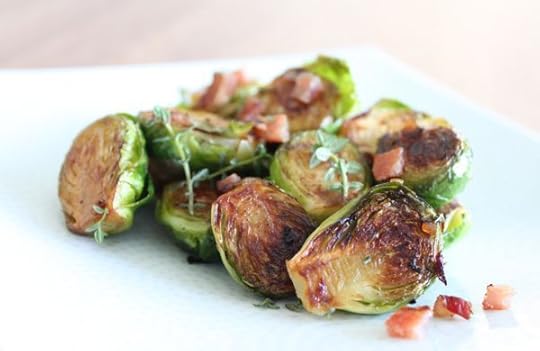 Veggie dishes offer a welcome respite from the meat and gravy and mashed starches.
Veggie dishes offer a welcome respite from the meat and gravy and mashed starches.
Bacon Brussels Sprouts with Brown Butter Vinaigrette - This is a hearty vegetable dish that can almost act like a main course.
Fall Vegetable Medley - Why limit yourself to one or two vegetable varieties? Treat your guests to the full spread of fall veggies, simply roasted and allowed to succeed on their own merits.
Grilled Okra with Spicy Sumac Seasoning Salt - It’s not your traditional Thanksgiving flavor. I’m a firm believer that every large homogenous meal needs a dish that stands out from the crowd and makes people take note.
Vegan Green Bean Casserole - Hey, we don’t hate the vegans. We can get along. This dish is the perfect way to make your vegan friend or family member feel at home as they eat it tucked away in the basement at the personal dinner table you’ve set up just for them. How nice! But seriously, it’s a legit green bean dish.
Green Beans with Lemon and Sage Crumbs - A nice twist on standard green bean dishes. And who doesn’t love chicken crumbs?
Root Roasts
I had trouble coming up with the perfect name for this category. Frankly, I’m not sure I’ve done it. You know what I mean, though, and that’s what matters.
Cider-Glazed Roots with Cinnamon Walnuts - Balsamic vinegar makes this one.
Roasted Beets and Pistachio Butter - I can guarantee that these are flavors you’ve never seen paired before.
Bourbon and Honey-Glazed Carrots - Bourbon isn’t just for drinking.
Harvest Blend – I don’t have a link for you. It’s just a dish that I usually throw together for the holidays. Gather a few strips of bacon, some coconut oil, cinnamon, sea salt, purple sweet potatoes, white sweet potatoes, a sweet apple (like a fuji), and a tart apple (like a goldrush or a granny smith). Chop up the bacon and roast it in a pan at 350 ºF until it gets soft and slightly (about halfway) cooked. Add the cubed sweet potatoes and coconut oil. Cook until nearly done, then add the diced apples (skin and all) and toss with salt and cinnamon. When the apples are caramelized, it’s done.
Mashes
 Mashes: they soak up gravy and fill your belly. They’re the backbone of the Thanksgiving plate. Many foods can be mashed, not just potatoes. Let’s take a look at a few of the best.
Mashes: they soak up gravy and fill your belly. They’re the backbone of the Thanksgiving plate. Many foods can be mashed, not just potatoes. Let’s take a look at a few of the best.
Broccoli-Carrot Mash - Lighter, greener, and more orange than standard mashed potatoes.
Roasted Butternut Squash Purée - Basic steamed butternut purée with butter is nice, but this recipe switches things up by roasting the squash, using coconut oil and sage, and mixing in macadamia nut meal. Really interesting, really tasty.
Rutabaga Purée and Lingonberry Mash - Try this reader-submitted Finnish recipe.
Mashed Cauliflower - Steamed or boiled cauliflower, grass-fed butter, a blender or food processor, some salt and pepper are all you need to create a low-carb version of mashed potatoes. You could also make a more elaborate version.
Mashed Parsnips - Parsnips get no love. They deserve lots. Love them and show them you love them by eating them; they’ll understand.
Sauces
 Candied Butternut Squash and Ginger Chutney - It’s a chutney that can also double as a side.
Candied Butternut Squash and Ginger Chutney - It’s a chutney that can also double as a side.
Simmered Cranberry Sauce and Spicy Cranberry Relish - Two cranberry sauces, each incredibly different from the other. I suggest making both and letting people choose.
Paleo Cran-Cherry Sauce - Cranberries, cherries, ginger: it’s a delicious confluence of powerful antioxidants that happens to go well with roasted turkey.
Cranberry Brown Butter Sauce - Butter really does make everything better. Heck, it’s practically right there in the word “butter” if you take out a “u” and add another “e.” In this sauce, butter mellows out the tartness of the cranberries.
Appetizers
 Thanksgiving dinner demands hearty appetites. Thanksgiving appetizers, then, should whet, not blunt, the appetite.
Thanksgiving dinner demands hearty appetites. Thanksgiving appetizers, then, should whet, not blunt, the appetite.
Crunchy Primal Crackers - Excellent vehicles for fine cheeses, dips, and spreads of all kinds.
Fig Tapenade - Great drivers for those crackers.
Smoked Bacon Oysters - Whatever you do, don’t make too many of these if you want people to save room for dinner. However many you make will be consumed in their entirety by your guests.
Simple Beet and Carrot Salad - Light and refreshing.
Desserts
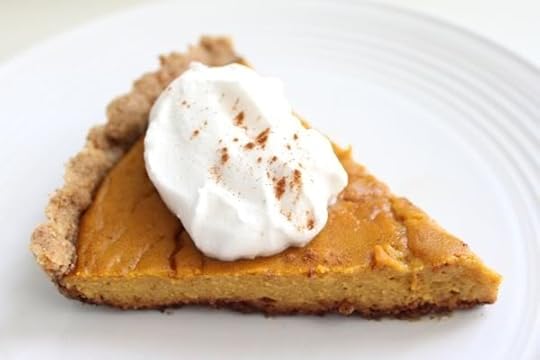 You gotta top Thanksgiving off with something sweet.
You gotta top Thanksgiving off with something sweet.
Primal Pumpkin Pie and Primal Apple Pie - The classics, made Primal.
Ultimate Walnut Pie Crust with Pumpkin Filling - Another Primal take on pumpkin pie.
Decadent Coconut Milk Whipped Cream with Berries and Dark Chocolate Coconut Mousse - The title pretty much says it all.
Ginger Molasses Cookies - Sometimes I really do miss gingersnaps. These are worthy replacements.
Apple Pie Tartlets - The word “tartlets” drew me in. Recipe’s great, too.
Paleo Maple, Pumpkin Custard Cups - These hit the perfect balance between sweet, buoyant, and pumpkin-y.
The Contest
I want your favorite Thanksgiving recipes. Your go-to dishes that you go back to time and time again. The ones you’ve perfected. The tried and the true. Or even just ones that you tried once and loved. Leave a recipe, or a link to a recipe, in the comment section below – they don’t have to be yours, but they do have to be a recipe you’ve actually tried. Obviously, this is an unenforceable rule. Honor system will have to do.
The winner gets a free copy of Primal Blueprint Healthy Sauces, Dressings & Toppings.
One entry per reader. Winner will be selected by random drawing. Contest ends at 11:59 pm PST tomorrow night, Wednesday, Nov. 27.
Thanks for reading, folks, and have a great Thanksgiving!
Order The Primal Blueprint Starter Kit and Take Control of Your Health Today!

November 25, 2013
Dear Mark: Cold Weather Carb Cravings, Muscle Loss in the Military, and Pain During Exercise
 For today’s edition of Dear Mark, we’ve got a two-parter. First, I cover why our desire for carbohydrates might increase in cold weather (hint: it’s probably all the shivering our muscles do in an attempt to stave off the chill). Second, I discuss why a military man might be losing muscle mass when out in the field, despite (or, perhaps, because of) all the hard physical work he’s doing. Even if you’re not military, the answer will likely still be helpful. And after that, Carrie lends a bit of sage advice to a reader who ends up with debilitating pain in her thighs every time she does high intensity plyometrics. The answer may not be what she had hoped for, but it’s probably the right one.
For today’s edition of Dear Mark, we’ve got a two-parter. First, I cover why our desire for carbohydrates might increase in cold weather (hint: it’s probably all the shivering our muscles do in an attempt to stave off the chill). Second, I discuss why a military man might be losing muscle mass when out in the field, despite (or, perhaps, because of) all the hard physical work he’s doing. Even if you’re not military, the answer will likely still be helpful. And after that, Carrie lends a bit of sage advice to a reader who ends up with debilitating pain in her thighs every time she does high intensity plyometrics. The answer may not be what she had hoped for, but it’s probably the right one.
Let’s go:
Hi Mark,
I am currently working a job where I spend every other week living outside leading backpacking trips. In the winter, temperatures will be in the 20s or 30s during the day and colder at night. I’ve noticed the last couple weeks that as the weather gets progressively colder, I’ve started craving carbs more and more. I was wondering if I need more carbs to help keep my body warm if I’m living for 8 days at a time in that cold of weather?
Thanks,
Briana
It could be a couple things.
The first thing I would guess is that you’re simply burning more fuel, particularly glycogen, acclimating to the colder temperatures. For example, shivering is used to generate heat and maintain body temperature in the face of cold exposure, and it utilizes a variety of fuel substrates, including lipids, glycogen, and to a much less extent, amino acids. But here’s the thing: even if you’re burning 50% lipids and 40% carbs, you have plenty of body fat to draw upon before turning to dietary sources – even the very lean have pounds and pounds of pure animal fat at their disposal. You’re not going to crave fat, necessarily, because you don’t need to eat any to replenish your stores.
What about glycogen? Glycogen stores are smaller, somewhere in the 400-500 gram range depending on the amount of lean mass you carry. Big muscular men will have larger glycogen stores (but they’ll also use more moving that mass through space). Women tend to have less lean mass and therefore smaller glycogen stores. Burning through glycogen increases the dietary desire for carbohydrate because dietary carbohydrate is the quickest way to replenish glycogen. You can generate it from protein (either through the diet or taken from your own lean mass) through gluconeogenesis, but the body prefers to get it directly. Fewer steps that way (plus, protein’s better used for other things). So, if you’re spending eight days outdoors where the temperature never gets much higher than freezing, you’ll be burning through a lot of glycogen – and craving carbs – simply from all the shivering you do. Throw in some activity (backpacking all day) on top of that and you’ve got a recipe for carb cravings.
You may also be experiencing a natural seasonal variation in hunger. Some researchers have even suggested that seasonal affective disorder, which as you know occurs during winter when the days are short and sun is scarce, might be an evolutionary adaptation that favors energy storage in otherwise inhospitable conditions. I can see that. SAD makes you sad and kind of gloomy, so you’re less likely to put yourself out there and take risks. It reduces your desire to exercise, which conserves energy. It lowers libido. It’s even associated with carb cravings. Nowadays, in our energy replete, already sedentary, carb inundated society, SAD has an overall negative impact on health. It’s not fun (or helpful) to be depressed, crave junk food, feel lazy, or have no libido. But thousands of years ago, it might have improved survival by keeping people alive, conserving energy, increasing energy stores, and limiting procreation in an energy-poor environment (which can have negative epigenetic effects on the fetus).
Under your circumstances, I think additional carbs may be warranted. Eat to your appetite.
My husband is in the military; when he goes to the field (any amount of time), he doesn’t eat a lot and does a lot of physical work. He comes back with way less muscle, and maybe a little fat loss but virtually the same. Why? Shouldn’t his muscles be using the fat instead? Can you clear this up? Thanks

Lauren
This is a textbook example of tons of physical activity coupled with low calorie intake begetting chronic elevations in cortisol. Let’s unpack this a bit.
Your husband is highly active in a demanding environment without eating enough food. If he’s wearing kit, that can add fifty, sixty pounds to the equation. He’s essentially on a chronic low-calorie diet, which is known to increase cortisol levels. Now, cortisol isn’t all bad. That burst of cortisol we secrete first thing in the morning can actually help mobilize fat stores. The problem is when cortisol is chronically elevated, as with formal dieting or doing lots of physical work without eating much. That’s when abdominal and visceral fat can accumulate and muscle begins to atrophy. The relationship between chronic cortisol and skeletal muscle is well-established. Older folks with the highest cortisol levels tend to have weaker grips than folks with normal cortisol, and those with high cortisol-to-testosterone ratios have reduced muscle strength.
I’m fairly certain this is the culprit.
It comes down, as it always does, to the question of acute versus chronic stress. A modest calorie deficit and exercise several times a week with generous refeeds is a good way to lose body fat. Your body won’t “think” you’re starving. It won’t buckle down and start making tough choices regarding which tissues to break down for fuel. Maintaining a severe calorie deficit and excessive exercise regimen for extended periods of time signals famine. Muscle is metabolically demanding. It’s awesome and useful and physically attractive, but it requires a lot of nutrients to maintain. If nutrients aren’t coming in for the foreseeable future – if your body thinks you’re experiencing famine – muscle will wane.
Muscle can’t be built (or even maintained) without the necessary building blocks: calories, fat (for hormone production), and protein. Your husband isn’t getting enough, and he’s burning through what little he does eat. Since the physical activity is probably nonnegotiable, his best bet is to cram as much food down his gullet as possible. This may mean eating less-than-Primal fare. Given the situation, that’s okay.
Good luck!
Dear Carrie: Pain During Exercise
My thighs (quads) kill me when I perform certain exercises such as squatting down, jumping up explosively, landing, and immediately repeating. Or when I do burpees, or do an exercise where I place my palms on the floor, invert myself into an upside-down V shape, and hop my legs from side to side, lifting my lower body with the core. Tuck jumps hurt. Even if I bend down to touch the floor, jump high up, and then land and bend down again on the other side and repeat… all of these exercises very quickly build pain in my quads that is excruciating to me and forces me to stop. When I do, the pain fades away within a minute.
Is this an overload of my muscles or what? I can’t seem to fully understand whether this is natural, if I did anything to cause it, if it will ever go away (I am praying it will). The seemingly constant and lurking presence of this possibility when I engage in such plyometrics (which I really really want to do) weighs down on my self-confidence and faith in my body.
I’d love for your feedback and advice with this nagging problem. =)
Thank you so much!
Helena
You have to slow down. Way, way down. It sounds like you may be trying to do too much too fast (literally; your exercise choices are intense and high speed). The excruciating pain is a warning sign that you’re risking serious damage to your body. That the pain disappears almost immediately is a “thank you” message meant to convince you to slow down the exercise. It’s best to listen to your body when it’s giving you such clear signals, or you risk doing some long term damage.
I’ve been there as well. I understand the urge to push through the pain at almost any cost. For years I had to get in a hard workout every day (usually some form of chronic cardio) or else I’d feel like the day wasn’t complete. Mark, as you probably know, used to be like this too, and maybe that’s part of the reason we got along so well: we bonded over our mutual addiction to exercise. The only way I got over it was to just stop doing the things that took a real toll on my body. I stopped running. I stopped going to the gym every day. I started hiking a lot and making my intense workouts much shorter (and by extension more intense and less frequent) than before. And it was hard and I worried I was going to gain weight and lose my fitness level. I stuck with it, and when those things didn’t come to pass and my fitness and body improved if anything, I was over it for good (at least so far!).
When I look at the exercises you describe, I see a lot of redundancy. Jumping squats, burpees, upside down hopping Vs, tuck jumps, and that other exercise that involves bending over and jumping – they’re all very quad dominant and they all involve a ton of force applied to very specific tissues. Namely, your thighs. There’s some core and some other stuff being worked, but it’s a lot of jumping and landing. That will add up over time and it seems like it is adding up already. When you get back into intense movements, stick to one per workout. Don’t ramp up and throw all those exercises at your body in one workout. You’re probably still growing, and even if you aren’t and you are a full grown adult, that would still be a heavy load for your legs.
Honestly, it comes down to the pain. If the pain is there, you’re doing something wrong and you need to rest.
So here’s what I would suggest:
Stop the calisthenics for the foreseeable future.
Use a foam roller before you train to help massage and release tight muscles. I use Trigger Point Performance Rollers by TPtherapy.com.
Try a weekly yoga class for increased flexibility, increased muscle strength and tone and protection from injury. (I may do 2-4 classes a week.)
So you don’t go crazy from inactivity, walk or hike a couple miles a day. Maybe even a couple more.
After a weeklong rest, start some easy, slow strength training. Bodyweight movements are fine. Dumbbells or barbells too. Stick to compound, full-body movements. Twice a week to start.
If you ever do go back to calisthenics, try box jumps. You still get the advantage of jumping as high as you can but you land on a box at the peak of your jump. This reduces the impact to your legs and joints. It’s easy to overdo box jumps, though, so be careful. Think quality and form over quantity. Note that it takes about 120 hours for your body to fully recover from box jumps (probably even longer for other, more stressful forms of calisthenics).
Sprints once a week. I find sprints have been by far the most effective in toning my butt and thighs, sometimes I’ll do them twice a week. Sprint uphill to reduce the impact.
Play! Find something you love doing, like a sport or any other physical activity that doesn’t involve repeating the same motion over and over again. (I love taking long beach walks and hikes with Mark!)
If the pain persists, see a medical professional and/or physical therapist.
Good luck and be sure to write in if you need anything else!
Well, that’s it for this week, folks. Got any questions for me and Carrie? Ask away in the comment board, and we’ll try to answer them in future blog posts. Thanks for reading!
Like This Blog Post? Dig Deeper with Primal Blueprint Books and Learn How You Can Reprogram Your Genes to Become Leaner, Stronger and Healthier

November 24, 2013
Weekend Link Love
 Research of the Week
Research of the WeekMice on a gluten-free diet developed far less spontaneous type 1 diabetes than mice on a gluten-containing diet. These differences in T1D incidence were reflected in the gut microbiome. Adding gluten into the gluten-free diet changed the microbiome and eliminated the protection against diabetes. In mice, at least, gluten appears to increase the risk of type 1 diabetes, a risk controlled by changes to the gut flora.
Nuts may have their share of omega-6 fats, but a recent study shows that their consumption is associated with a rather significant reduction in mortality. Cautionary note: do not assume that nuts confer immortality.
Interesting Blog Posts
Are the ketogenic nursing mother’s ketones killing her baby? Or is it the Crisco her ketogenic diet is based on?
America’s obesity rates are on the upswing again. That didn’t last long.
Media, Schmedia
What one leading neurologist thinks grain is doing to your brain (provided you still eat the stuff, of course). It isn’t pretty.
America being one of the only countries in the world to wash and refrigerate its eggs is not an example of American exceptionalism, sadly. It turns out washing eggs may increase the risk of salmonella contamination.
A funny (because it’s true) take on the new statin guidelines.
Satire or Serious?
The artery-clogging, social fiber-destroying impact of banning trans-fats: people might eat more saturated fat!
Everything Else
The “Indigenous Games” in Brazil is an alternative to the World Cup/Olympics that prides itself on celebration rather than competition. I like healthy competition myself, but this looks pretty cool. Who’s up for a xikunahity match at the next PrimalCon?
China is “launching seeds into space to take advantage of cosmic radiation and low gravity.” That’s certainly an interesting way to genetically modify foods.
When you slow down a cricket’s chirping, it sounds like a chorus of angels.
Not a fan of standing or treadmill desks? Enter the Pedal Power, a pedal-powered work surface that lets you power your laptop (and other electronics) with your legs.
Move over, Generation X, Generation Y, Millennials! The Slowpoke Generation (a global phenomenon, by the way) is coming your way (albeit really, really slowly).
We may be entering a world without (working) antibiotics. I’d watch a gritty dystopian sci-fi flick starring Michael Fassbender with that premise, but I don’t want to live there.
A Canadian family was recently fined $10 by an elementary school for failing to provide grains in their child’s lunchbox. Luckily, the neglected child’s meager, unbalanced meal of meat, potatoes, carrots, oranges, and milk was enhanced by the addition of Ritz crackers by school staffers.
According to the Atlantic, apple cores are a myth. I’m not so sure. I definitely detect a difference in taste and texture between the “core” and the rest of the apple. What about you?
Recipe Corner
Bacon and butternut squash “risotto.” The quotation marks are key here.
Gravy can be tricky. Nom Nom Paleo’s umami gravy takes all the guesswork out of it.
Time Capsule
One year ago (Nov 24 – Nov 30)
The Physical Toll of Negative Emotions – How emotions are not somehow separate from our bodies, and how negative ones can actually have physical ramifications.
Top 9 Most Important Foods to Buy Organic – Which organic foods should your prioritize?
Comment of the Week
I was skimming and missed both mentions of Dear Carrie. So I did a pretty good doubletake when I read “In fact, I breastfed Devyn for two years…”
- Yeah, I tried and failed miserably. Couldn’t get a good latch going to save my life.
Have You Seen the New Primal Book? Discover The Hidden Plague and the Special Offer That Expires on Nov. 30

Mark Sisson's Blog
- Mark Sisson's profile
- 199 followers



